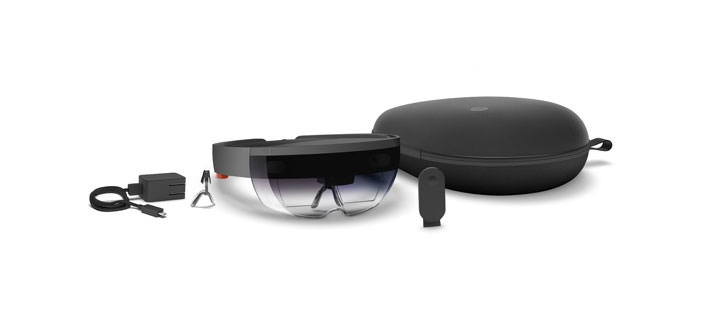As anticipated from earlier rumors, Microsoft will officially kick off the pre-orders of Hololens viewer, the same time conveying the price and date of arrival. The Development Edition Viewer will cost $ 3,000 and will be delivered in USA and Canada from 30 March.
Microsoft, officially has the green light to the Development Edition preorders of augmented reality Hololens viewer. Confirmed the selling price of $ 3000 and the start of deliveries scheduled for March 30 in the US and Canada.
It is a step further in view of the commercialization of the consumer version of the viewer; to have the opportunity to purchase Hololens Development Edition will indeed only developers interested in building and testing your software optimized for it.
The start of pre-orders, at the same time, represents a good opportunity to deepen aspects of hardware and the operation of the device. Microsoft has published the complete technical specifications and published an interesting series of Hololens dedicated to video tutorials.
Microsoft, until now, it is never too fell into detail regarding the built-in hardware Hololens that, remember, is a stand-alone device that incorporates the components necessary to the operation, without depending on the PC connection. The opening of pre-orders let’s take a closer look at the technical details, the following structure:
- Display : see-through holographic lenses (waveguides), light engine 2 HD 16: 9, automatic calibration of the eye distance, holographic resolution: 2,300,000 Total light points, 2,500 points for radiating light.
- Sensors : IMU (inertial measurement unit), 4 cameras for the ” spatial mapping “, mixed reality capture, 4 microphones, ambient light sensor.
- Processor : 1.0 HPU (Holographic Processing Unit), Microsoft custom CPU based on Intel 32-bit architecture.
- Memory : 2 GB of RAM and 64 GB of storage.
- Camera : 2 MP photos and videos in HD.
- Audio : External speakers, a 3.5mm audio jack.
- Connectivity : Wi-Fi 802.11ac, Bluetooth 4.1 LE, Micro-USB 2.0.
- Power : autonomy 2-3 hours of active use, two weeks on standby, passive cooling.
- Weight : 579 grams.
- Operating system : Windows 10 Windows Store Human Understanding: spatial sound, gaze tracking, input via gesture, voice support.
It should be noted that the newly listed properties may be susceptible to changes in the commercial version of the viewer. Desirable, for example, that the autonomy parameter to be improved in the future. Premature to make assessments on the consumer version of Hololens, since his arrival cannot be defined imminent.
The official video shows the contents of the package, including the viewer, a clicker Bluetooth – allowing you to select, scroll and interact with the elements contained in the holographic scenarios – the charger and micro USB 2.0 cable, a microfiber cloth and a bag for the transport.
Developers can begin to test the potential of the viewer with a series of holographic apps prepared for the launch and comprising HoloStudio, a version of Skype optimized for Hololens, without neglecting gaming with RoboRaid, Young Conker and Fragments.
Microsoft’s main goal at this stage of the life cycle is Hololens offer developers the tool to create holographic content for the viewer. The Redmond started to provide developer support material for creating apps for Hololens.
In the video tutorial below, for example, it provides an overview of application development activity, starting from the forms of interaction with the content projected by the viewer in the surroundings: the look, the gesture and voice.
Another feature highlighted concerns the ” spatial mapping “, ie the viewer’s ability to establish the structure of the environment surrounding the purpose of projecting holograms on actual objects. To improve the involvement with reality holographic developers can take advantage of the ” spatial sound ” or the ability to play 360-degree sound.
Not to be overlooked, most recently, the use of a universal windows platform (UWP): holographic apps are basically universal app Windows 10 and, potentially, every universal app supports playback through Hololens viewer.
Microsoft then goes down into the details of individual features with a series of video tutorials that you can see by logging on to the official YouTube channel dedicated to Hololens. For reference, adding that developers interested in building and testing app for holographic Hololens viewer does not necessarily have to own it: between the various tools developed by Microsoft Figure fact also an emulator that allows you to try the app to your PC even without the viewer.
The emulator uses a virtual machine Hyper-V and simulates using keyboard, mouse or an Xbox controller human and environmental inputs that are usually read by sensors integrated into the viewer. More details on the emulator, and development tools for the app Hololens be found by logging on to this address.
You cannot be established, at the time, when the Hololens project will mature to the point to make his debut in the consumer segment, but the arrival of the version for developers is a key step to reach this goal.
Even the most advanced hardware is of little use if not properly supported in software. It is now up to the developer community the most important task: to create the holographic app.

